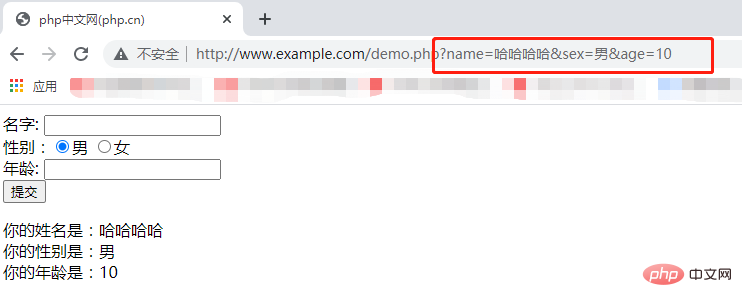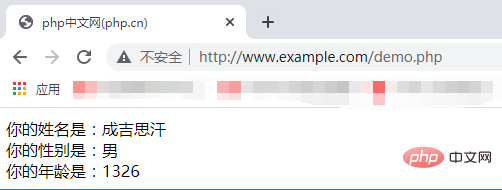 Backend Development
Backend Development
 PHP Tutorial
PHP Tutorial
 PHP form learning: The use and difference of $_GET and $_POST variables
PHP form learning: The use and difference of $_GET and $_POST variables
PHP form learning: The use and difference of $_GET and $_POST variables
In the previous article, I brought you "PHP form learning: How to verify the email and URL in the form?" ", which introduces in detail the knowledge about how to verify emails and URLs in forms in PHP. In this article, we take a look at the $_GET variables and $_POST variables in PHP. I hope everyone has to help!

In the previous article we have learned how to validate the required data and how to validate the email and URL in the form through regular expressions. Among them are the shadows of $_GET variables and $_POST variables. Next, let’s take a look at $_GET variables and $_POST Knowledge related to the use of variables.
<span style="font-size: 20px;">PHP $_GET </span>Variables
We have learned about it before when we were studying# The ##$_GET variable is used to collect values from the form with method="get". Information sent from a form with the GET method is visible to everyone (displayed in the browser's address bar), and there are limits on the amount of information sent. In fact, it can also be viewed as an array of variables passed to the current script through URL parameters.
<html>
<head>
<meta charset="utf-8">
<title>php中文网(php.cn)</title>
</head>
<body>
<form action="demo.php" method="get">
名字: <input type="text" name="name"><br>
性别:<input type="radio" name="sex" value="男" checked>男
<input type="radio" name="sex" value="女">女<br>
年龄: <input type="text" name="age"><br>
<input type="submit" value="提交">
</form>
</body>
</html><?php
header("Content-type:text/html;charset=utf-8"); //设置编码
echo "你的姓名是:" .$_GET['name'] ."<br/>";
echo "你的性别是:" .$_GET['sex']."<br/>";
echo "你的年龄是:".$_GET['age'];
?>

method="get" in an HTML form, all variable names and values will be displayed in the URL. So you should not use this method when sending passwords or other sensitive information! However, because the variables appear in the URL, you can bookmark the page. In some cases this is useful.
<strong>$_POST<span style="max-width:90%"></span></strong> Variables
$_GET variable, let’s take a look at the $_POST variable. The predefined $_POST variable is used to collect data from method= The value in the form of "post".
$_GET variable, and is not visible to anyone. There is also no limit to the amount of information. However, by default, the maximum amount of information sent by the POST method is 8 MB, which can be changed by setting post_max_size in the php.ini file.
<html>
<head>
<meta charset="utf-8">
<title>php中文网(php.cn)</title>
</head>
<body>
<form action="demo.php" method="post">
名字: <input type="text" name="name"><br>
性别:<input type="radio" name="sex" value="男" checked>男
<input type="radio" name="sex" value="女">女<br>
年龄: <input type="text" name="age"><br>
<input type="submit" value="提交">
</form>
</body>
</html><?php
header("Content-type:text/html;charset=utf-8"); //设置编码
echo "你的姓名是:" .$_POST['name'] ."<br/>";
echo "你的性别是:" .$_POST['sex']."<br/>";
echo "你的年龄是:".$_POST['age'];
?>
##$_GET<strong><span style="font-size: 20px;"></span></strong> and $_POST
is to obtain data from the server, and post is to transmit data to the server. get adds the parameter data queue to the URL pointed to by the ACTION attribute of the submitted form. The value corresponds to each field in the form and can be seen in the URL. Post uses the HTTP post mechanism to place each field in the form and its content in the HTML HEADER and transmit it to the URL address pointed to by the ACTION attribute. Users cannot see this process.
For the get method, the server side uses Request.QueryString to obtain the value of the variable. For the post method, the server side uses Request.Form to obtain the submitted data.
The amount of data transferred by get is small and cannot be larger than 2KB. The amount of data transmitted by post is relatively large and is generally unrestricted by default. But in theory, the maximum amount is 80KB in IIS4 and 100KB in IIS5.
Get security is very low, post security is high. But the execution efficiency is better than the Post method.
The differences between the two are organized into a table. The table is as follows:
| $_POST | ||
|---|---|---|
| There will be a limit on the number of characters that will be displayed in the URL | ||
| Generally a small amount of data less than 2k | PHP can submit a large amount of 8M data by default | |
| Unsafe | More secure | |
| The submitted data is isolated | Submit the data as a whole | |
| Very flexible, you can transfer data with a page jump | Not flexible, you must have the participation of a form | |
| More commonly used | Less compared with $_GET |
- The get method is less secure than the Post method. If confidential information is included, it is recommended to use the Post data submission method;
- is working When querying data, it is recommended to use the Get method; when adding, modifying or deleting data, it is recommended to use the Post method;
- If you are interested, you can click "
》Learn more about PHP knowledge.
The above is the detailed content of PHP form learning: The use and difference of $_GET and $_POST variables. For more information, please follow other related articles on the PHP Chinese website!

Hot AI Tools

Undresser.AI Undress
AI-powered app for creating realistic nude photos

AI Clothes Remover
Online AI tool for removing clothes from photos.

Undress AI Tool
Undress images for free

Clothoff.io
AI clothes remover

Video Face Swap
Swap faces in any video effortlessly with our completely free AI face swap tool!

Hot Article

Hot Tools

Notepad++7.3.1
Easy-to-use and free code editor

SublimeText3 Chinese version
Chinese version, very easy to use

Zend Studio 13.0.1
Powerful PHP integrated development environment

Dreamweaver CS6
Visual web development tools

SublimeText3 Mac version
God-level code editing software (SublimeText3)

Hot Topics
 PHP 8.4 Installation and Upgrade guide for Ubuntu and Debian
Dec 24, 2024 pm 04:42 PM
PHP 8.4 Installation and Upgrade guide for Ubuntu and Debian
Dec 24, 2024 pm 04:42 PM
PHP 8.4 brings several new features, security improvements, and performance improvements with healthy amounts of feature deprecations and removals. This guide explains how to install PHP 8.4 or upgrade to PHP 8.4 on Ubuntu, Debian, or their derivati
 7 PHP Functions I Regret I Didn't Know Before
Nov 13, 2024 am 09:42 AM
7 PHP Functions I Regret I Didn't Know Before
Nov 13, 2024 am 09:42 AM
If you are an experienced PHP developer, you might have the feeling that you’ve been there and done that already.You have developed a significant number of applications, debugged millions of lines of code, and tweaked a bunch of scripts to achieve op
 How To Set Up Visual Studio Code (VS Code) for PHP Development
Dec 20, 2024 am 11:31 AM
How To Set Up Visual Studio Code (VS Code) for PHP Development
Dec 20, 2024 am 11:31 AM
Visual Studio Code, also known as VS Code, is a free source code editor — or integrated development environment (IDE) — available for all major operating systems. With a large collection of extensions for many programming languages, VS Code can be c
 Explain JSON Web Tokens (JWT) and their use case in PHP APIs.
Apr 05, 2025 am 12:04 AM
Explain JSON Web Tokens (JWT) and their use case in PHP APIs.
Apr 05, 2025 am 12:04 AM
JWT is an open standard based on JSON, used to securely transmit information between parties, mainly for identity authentication and information exchange. 1. JWT consists of three parts: Header, Payload and Signature. 2. The working principle of JWT includes three steps: generating JWT, verifying JWT and parsing Payload. 3. When using JWT for authentication in PHP, JWT can be generated and verified, and user role and permission information can be included in advanced usage. 4. Common errors include signature verification failure, token expiration, and payload oversized. Debugging skills include using debugging tools and logging. 5. Performance optimization and best practices include using appropriate signature algorithms, setting validity periods reasonably,
 How do you parse and process HTML/XML in PHP?
Feb 07, 2025 am 11:57 AM
How do you parse and process HTML/XML in PHP?
Feb 07, 2025 am 11:57 AM
This tutorial demonstrates how to efficiently process XML documents using PHP. XML (eXtensible Markup Language) is a versatile text-based markup language designed for both human readability and machine parsing. It's commonly used for data storage an
 PHP Program to Count Vowels in a String
Feb 07, 2025 pm 12:12 PM
PHP Program to Count Vowels in a String
Feb 07, 2025 pm 12:12 PM
A string is a sequence of characters, including letters, numbers, and symbols. This tutorial will learn how to calculate the number of vowels in a given string in PHP using different methods. The vowels in English are a, e, i, o, u, and they can be uppercase or lowercase. What is a vowel? Vowels are alphabetic characters that represent a specific pronunciation. There are five vowels in English, including uppercase and lowercase: a, e, i, o, u Example 1 Input: String = "Tutorialspoint" Output: 6 explain The vowels in the string "Tutorialspoint" are u, o, i, a, o, i. There are 6 yuan in total
 Explain late static binding in PHP (static::).
Apr 03, 2025 am 12:04 AM
Explain late static binding in PHP (static::).
Apr 03, 2025 am 12:04 AM
Static binding (static::) implements late static binding (LSB) in PHP, allowing calling classes to be referenced in static contexts rather than defining classes. 1) The parsing process is performed at runtime, 2) Look up the call class in the inheritance relationship, 3) It may bring performance overhead.
 What are PHP magic methods (__construct, __destruct, __call, __get, __set, etc.) and provide use cases?
Apr 03, 2025 am 12:03 AM
What are PHP magic methods (__construct, __destruct, __call, __get, __set, etc.) and provide use cases?
Apr 03, 2025 am 12:03 AM
What are the magic methods of PHP? PHP's magic methods include: 1.\_\_construct, used to initialize objects; 2.\_\_destruct, used to clean up resources; 3.\_\_call, handle non-existent method calls; 4.\_\_get, implement dynamic attribute access; 5.\_\_set, implement dynamic attribute settings. These methods are automatically called in certain situations, improving code flexibility and efficiency.





